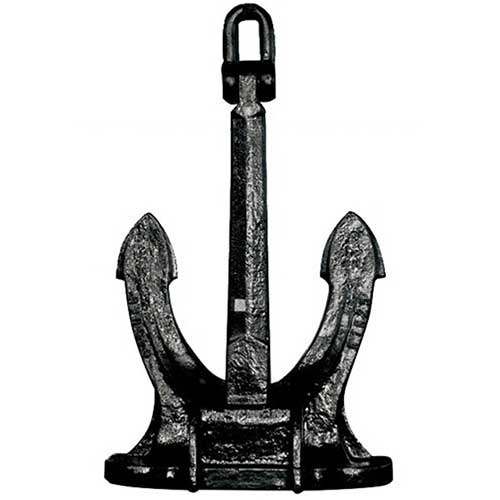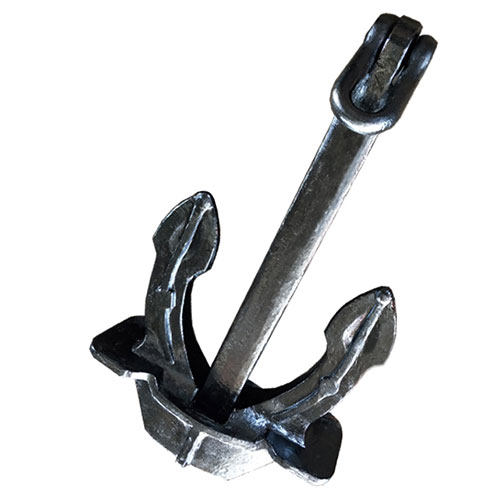Stockless anchors are gaining popularity in marine applications due to their versatility and compact design. These anchors, suitable for small boats and large ships alike, offer a range of advantages for various seabed conditions. In this article, we will explore on the topic of what are stockless anchors, including the definition, design components, types, installation, maintenance, and the advantages and disadvantages of stockless anchors.

Definition of Stockless Anchors:
A stockless anchor is a type of marine anchor that lacks a vertical bar called a stock, which assists in proper pivoting and setting on the seafloor. Instead, the shank of a stockless anchor is directly attached to the anchor chain or rope. This design allows the anchor to rotate and dig into the seafloor without the need for a stock. Stockless anchors are popular due to their small size, ease of use, and ability to provide reliable holding power in various seabed conditions.
Design and Components of Stockless Anchors:
While the design and components of stockless anchors may vary depending on the manufacturer and intended purpose, they typically consist of the following parts:
Shank: The shank serves as the anchor's main body, providing the necessary weight and structure to keep the anchor in place. It features a bent or fluked end that aids in digging into the seafloor.
Flukes: Flukes are the flat, curved, or pointed sections of the anchor that dig into the seafloor, providing gripping power. They can be shaped like a scoop or a wing and vary in number, size, and angle based on the anchor's size and type.
Crown: The crown is the top part of the anchor, typically featuring a hole or slot for attaching the anchor chain or rope.
Tripping Ring: A small ring attached to the crown, the tripping ring is used in emergencies to remove the anchor from the seabed.
Chain or Rope: The anchor chain or rope connects the anchor to the boat, supplying the necessary tension to keep the anchor in place. A shackle is often used to secure it to the anchor's crown.
Various Types of Stockless Anchors:
Stockless anchors come in different types, each suited for specific marine applications and seabed conditions. Some common types include:
AC-14 Anchor: This anchor offers excellent dragging resistance and holding force, commonly found on offshore oil rigs and large marine vessels.
Hall Anchor: Lightweight and compact, the Hall anchor is ideal for smaller vessels, providing good holding power in soft to moderate seabed conditions.
Spek Anchor: Designed for challenging seabed conditions like rocks, the Spek anchor is a heavy-duty option frequently used on large ships and offshore rigs.

Pool Anchor: Pool anchors are versatile and adaptable, suitable for a variety of bottom conditions such as mud, sand, and rock. They are commonly seen on small to medium-sized ships.
Baldt Anchor: With high-strength capabilities, Baldt anchors are used in heavy-duty marine applications like oil rigs and large cargo ships.
Delta Anchor: Popular among recreational boats and smaller commercial vessels, the Delta anchor offers strong holding ability across different seabed situations.
Installation and Maintenance of Stockless Anchors:
Proper installation and maintenance are crucial for the optimal performance and longevity of stockless anchors. Follow these guidelines for installation and maintenance:
Installation:
Before installation, inspect the chain or rope for any damage such as fraying, rust, or wear and tear. Replace any damaged components before proceeding.
Ensure the anchor is appropriate for the size and weight of the vessel and the seabed conditions. Follow the manufacturer's instructions regarding chain or rope lengths.
Lower the anchor carefully and gradually, paying out the chain or rope to avoid damaging the anchor and to ensure proper placement on the seabed.
Verify that the boat is securely fastened in place once the anchor is set.
Maintenance:
After each use, inspect the anchor for any damage or wear, such as bent flukes or cracks in the shank. Rectify any damage or consider replacing the anchor if necessary.
Regularly clean the anchor to prevent corrosion and rust, which can weaken its holding capacity.
Inspect the chain or rope periodically for deterioration, corrosion, or fraying. Replace any damaged sections promptly.
Follow the manufacturer's instructions for maintenance and inspection intervals, which may vary depending on the material and usage of the anchor.

Advantages and Disadvantages of Stockless Anchors:
Consider the following advantages and disadvantages when selecting a stockless anchor for your marine application:
Advantages:
Compact design facilitates easier handling and storage.
Easy deployment, especially in shallow waters.
Good holding power on various seabed conditions.
Reduced risk of snagging on underwater debris.
Versatile and suitable for a wide range of vessels.
Disadvantages:
Limited pivoting capability compared to anchors with stocks.
May not perform as effectively in high winds.
Limited holding power in hard seabeds.
May require more frequent maintenance due to compact design.
Higher cost, particularly for high-strength materials.
Summary
Stockless anchors offer a compact and versatile solution for marine applications. Their design, lack of stock, and various components enable ease of use, reliability, and efficient anchoring. By understanding the advantages and disadvantages of stockless anchors, as well as considering specific requirements for each application, you can make an informed decision when selecting the most suitable anchor for your marine needs.






Comments (0)